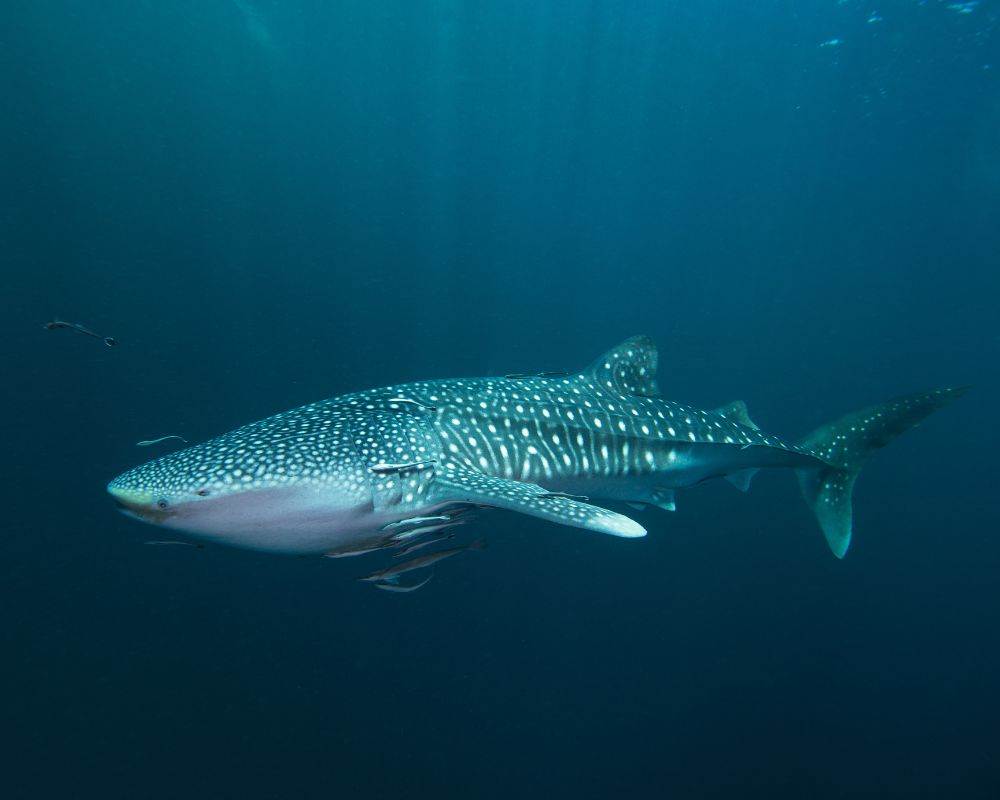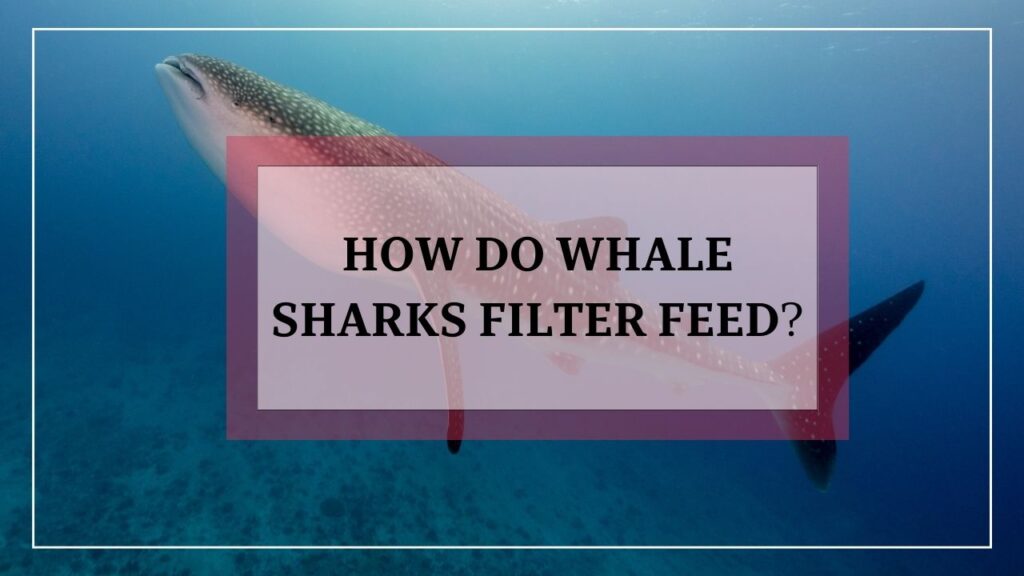Have you ever seen a whale shark up close? These magnificent creatures are truly a sight to behold. With their massive size and distinctive spotted pattern, they capture the imagination of anyone who sees them. But have you ever wondered how they eat?
Whale sharks are filter feeders, meaning they consume tiny organisms in the water by filtering them through their gills. It’s a fascinating process that is crucial to the survival of these gentle giants, and today we’re going to explore it in depth.
As you read on, you’ll learn all about how whale sharks filter feed and why it’s so important. In this blog post, we provide a unique perspective on this fascinating process. So buckle up and get ready to dive into the world of whale shark filter feeding.
Let’s first start with how the anatomy of whale sharks helps in its filtering process:
Anatomy of a Whale Shark

Whale sharks are the largest fish in the world, and their size is just one of the many unique features that make them fascinating creatures. In this section, we’ll take a closer look at the anatomy of a whale shark and explore how its physical characteristics facilitate filter feeding.
1. Physical Characteristics
Size And Weight
Whale sharks can grow up to 40 feet in length and weigh up to 20 tons. That’s larger than some species of whales! Their massive size makes them easy to spot in the water and is a testament to their strength and resilience.
Mouth Structure
Whale sharks have massive mouths that can open up to five feet wide. Their mouths are located on the front of their heads, which allows them to swim forward with their mouths wide open to consume prey. Additionally, their mouths are lined with up to 300 rows of tiny teeth, but they’re not used for biting or chewing food.
Gill Rakers
Perhaps the most important feature of a whale shark’s anatomy when it comes to filter-feeding is its gill rakers. Gill rakers are long, thin structures located on the gills of a whale shark. They act like a filter, trapping tiny plankton and other organisms as water passes through the gills. Whale sharks have five large gill slits on each side of their bodies, and each gill slit contains hundreds of gill rakers.
2. How Do These Features Facilitate Filter Feeding
Large Mouth
The whale shark’s largemouth is the first step in filter feeding. By opening their mouth wide, they can engulf large amounts of water that contain tiny plankton and other organisms. Their large mouth allows them to filter feed on a massive scale, consuming up to 1,500 gallons of water per hour!
Unique Jaw Structure
Another important feature of the whale shark’s anatomy when it comes to filter-feeding is its unique jaw structure. The jaws of a whale shark are not fused to their skull like other sharks. Instead, they are connected to muscles that allow them to protrude their jaws forward. This enables them to create a sort of suction that draws water and prey into their mouths.
Gill Rakers And Their Function
Finally, the gill rakers on a whale shark’s gills are crucial to filter feeding. As water passes through their gills, the gill rakers trap tiny organisms like plankton and krill. The whale shark then uses their tongue to push the trapped organisms toward the back of their mouth, where it can be swallowed whole.
In the next section, we’ll explore the process of filter feeding in more detail.
The Process of Filter Feeding
Filter feeding is a unique feeding strategy used by whale sharks to consume tiny organisms like plankton and krill. In this section, we will explore the process of filter feeding in greater detail.
1. Prey Selection
Types Of Plankton Consumed
Whale sharks consume a variety of planktonic organisms, including copepods, krill, and small fish. Copepods are the primary food source for whale sharks, making up more than half of their diet.
How Whale Sharks Locate Prey
Whale sharks locate prey by using their highly developed senses, including their sense of smell and their ability to detect the small water movements created by planktonic organisms. Once they have located a source of prey, they will begin the process of filter feeding.
2. Ingestion
How The Whale Shark’s Mouth Opens And Closes
Whale sharks have large, wide mouths that can open up to four feet wide. They use their mouths to create suction, which allows them to draw in water and prey.
How They Create Suction To Draw In Water And Prey
To create suction, whale sharks close their mouths and then rapidly open them again. This action creates a pressure differential that sucks water and prey into their mouths.
3. Filtration
How The Whale Shark Filters Out Water
As the water and prey enter the whale shark’s mouth, they pass over the gill rakers, which act like a sieve. The gill rakers are lined with tiny hair-like structures that trap the plankton and other tiny organisms while allowing the water to pass through.
The Role Of The Gill Rakers Infiltration
The gill rakers play a critical role in the filtration process, as they prevent larger particles from entering the whale shark’s mouth while allowing smaller particles to be filtered out. Once the prey has been filtered out, the whale shark uses its tongue to move it toward the back of its mouth, where it can be swallowed and digested.
The Importance of Whale Shark Filter Feeding
1. The Importance Of Filter Feeding For Whale Sharks
Filter feeding is an essential behavior for whale sharks as it is the primary way they obtain their food. These gentle giants consume a significant amount of plankton, small fish, and crustaceans through filter feeding. Without this behavior, they would not be able to survive.
2. Impact On The Marine Ecosystem
How They Maintain Ecological Balance
Whale sharks are essential in maintaining the ecological balance of the marine ecosystem. By consuming a significant amount of plankton, they help regulate the populations of these organisms in the ocean. This regulation of plankton populations is crucial as they are the foundation of the oceanic food chain. If their populations are not kept in check, it can have a ripple effect on the entire ecosystem.
How They Support Other Marine Life
Whale sharks also play an important role in supporting other marine life. Their filter-feeding behavior attracts a variety of marine species that feed on scraps and leftovers. This behavior creates an ecosystem where many other species thrive, contributing to a healthy and diverse marine ecosystem.
The Bottom Line
In conclusion, the process of filter feeding in whale sharks is a fascinating and unique behavior that allows these gentle giants to thrive in the oceanic environment. Their filter feeding not only sustains their own lives but also plays a crucial role in maintaining the ecological balance of the marine ecosystem.
As we continue to learn more about these magnificent creatures, it is our responsibility to protect and conserve them for the benefit of the entire planet.

